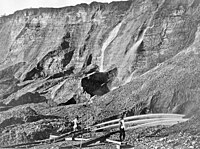
Photo from wikipedia
Abstract In the flotation process of copper sulfide, traditional inorganic depressants used for pyrite often cause environmental problems and difficulty in treatment of the tailings and waste water. Therefore, it… Click to show full abstract
Abstract In the flotation process of copper sulfide, traditional inorganic depressants used for pyrite often cause environmental problems and difficulty in treatment of the tailings and waste water. Therefore, it is necessary to explore non-polluting and efficient flotation reagents to make mineral processing environmentally friendly and sustainable. In this work, salicylic acid (SA) has been studied for adsorption on pyrite and chalcopyrite surfaces by surface-adsorption experiments. The interaction mechanism of SA with pyrite surfaces was demonstrated by zeta potential measurements, infrared spectroscopy, time-of-flight secondary-ion mass spectrometry (ToF-SIMS), and X-ray photoelectron spectroscopy (XPS). The impact of SA on the flotation behavior of chalcopyrite and pyrite was further verified by microflotation experiments. Adsorption experiments indicated that SA dramatically reduced the adsorption amounts of xanthate on pyrite surfaces, yet it exhibited a weaker impact on adsorption of xanthate on chalcopyrite surfaces. The zeta potential results showed that the potential of pyrite increased among an extensive pH range after treatment of SA. a new characteristic peak appeared in the pyrite–SA infrared spectrum. ToF-SIMS and XPS analysis of the pyrite–SA surfaces revealed a strong interaction between SA and Fe sites. Microflotation tests confirmed that SA had an obvious depression effect on pyrite, yet no clear depression effect on chalcopyrite. These results verified that selective adsorption of SA on pyrite weaken the floatability of pyrite, thereby enabling separation of chalcopyrite from pyrite at low alkalinity.
Journal Title: Separation and Purification Technology
Year Published: 2020
Link to full text (if available)
Share on Social Media: Sign Up to like & get
recommendations!